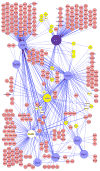Concise review: The Sox2-Oct4 connection: critical players in a much larger interdependent network integrated at multiple levels
- PMID: 23401375
- PMCID: PMC3664101
- DOI: 10.1002/stem.1352
Concise review: The Sox2-Oct4 connection: critical players in a much larger interdependent network integrated at multiple levels
Abstract
The transcription factors Sox2 and Oct4 have been a major focus of stem cell biology since the discovery, more than 10 years ago, that they play critical roles during embryogenesis. Early work established that these two transcription factors work together to regulate genes required for the self-renewal and pluripotency of embryonic stem cells (ESC). Surprisingly, small changes (∼twofold) in the levels of either Oct4 or Sox2 induce the differentiation of ESC. Consequently, ESC must maintain the levels of these two transcription factors within narrow limits. Genome-wide binding studies and unbiased proteomic screens have been conducted to decipher the complex roles played by Oct4 and Sox2 in the transcriptional circuitry of ESC. Together, these and other studies provide a comprehensive understanding of the molecular machinery that sustains the self-renewal of ESC and restrains their differentiation. Importantly, these studies paint a landscape in which Oct4 and Sox2 are part of a much larger interdependent network composed of many transcription factors that are interconnected at multiple levels of function.
Copyright © 2013 AlphaMed Press.
Conflict of interest statement
The author indicates no potential conflicts of interest.
Figures


Similar articles
-
Zfp206, Oct4, and Sox2 are integrated components of a transcriptional regulatory network in embryonic stem cells.J Biol Chem. 2009 Nov 6;284(45):31327-35. doi: 10.1074/jbc.M109.016162. Epub 2009 Sep 9. J Biol Chem. 2009. PMID: 19740739 Free PMC article.
-
Determination of protein interactome of transcription factor Sox2 in embryonic stem cells engineered for inducible expression of four reprogramming factors.J Biol Chem. 2012 Mar 30;287(14):11384-97. doi: 10.1074/jbc.M111.320143. Epub 2012 Feb 9. J Biol Chem. 2012. PMID: 22334693 Free PMC article.
-
Sox2/Oct4: A delicately balanced partnership in pluripotent stem cells and embryogenesis.Biochim Biophys Acta. 2016 Jun;1859(6):780-91. doi: 10.1016/j.bbagrm.2016.03.006. Epub 2016 Mar 23. Biochim Biophys Acta. 2016. PMID: 26992828 Review.
-
Transient pairing of homologous Oct4 alleles accompanies the onset of embryonic stem cell differentiation.Cell Stem Cell. 2015 Mar 5;16(3):275-88. doi: 10.1016/j.stem.2015.02.001. Cell Stem Cell. 2015. PMID: 25748933 Free PMC article.
-
Directing reprogramming to pluripotency by transcription factors.Curr Opin Genet Dev. 2012 Oct;22(5):416-22. doi: 10.1016/j.gde.2012.07.001. Epub 2012 Aug 3. Curr Opin Genet Dev. 2012. PMID: 22868173 Review.
Cited by
-
Pluripotency and Epigenetic Factors in Mouse Embryonic Stem Cell Fate Regulation.Mol Cell Biol. 2015 Aug;35(16):2716-28. doi: 10.1128/MCB.00266-15. Epub 2015 Jun 1. Mol Cell Biol. 2015. PMID: 26031336 Free PMC article. Review.
-
Icaritin enhances mESC self-renewal through upregulating core pluripotency transcription factors mediated by ERα.Sci Rep. 2017 Jan 16;7:40894. doi: 10.1038/srep40894. Sci Rep. 2017. PMID: 28091581 Free PMC article.
-
SOX-2, but not Oct4, is highly expressed in early-stage endometrial adenocarcinoma and is related to tumour grading.Int J Clin Exp Pathol. 2015 Jul 1;8(7):8189-98. eCollection 2015. Int J Clin Exp Pathol. 2015. PMID: 26339387 Free PMC article.
-
Glucose-6-phosphate dehydrogenase is indispensable in embryonic development by modulation of epithelial-mesenchymal transition via the NOX/Smad3/miR-200b axis.Cell Death Dis. 2018 Jan 9;9(1):10. doi: 10.1038/s41419-017-0005-8. Cell Death Dis. 2018. PMID: 29317613 Free PMC article.
-
Silencing VDAC1 to Treat Mesothelioma Cancer: Tumor Reprograming and Altering Tumor Hallmarks.Biomolecules. 2022 Jun 27;12(7):895. doi: 10.3390/biom12070895. Biomolecules. 2022. PMID: 35883451 Free PMC article.
References
-
- Smith AG. Embryo-derived stem cells: of mice and men. Annu Rev Cell Dev Biol. 2001;17:435–462. - PubMed
-
- Wilder PJ, Rizzino A. Mouse genetics in the 21st century: using gene targeting to create a cornucopia of mouse mutants possessing precise genetic modifications. Cytotechnology. 1993;11:79–99. - PubMed
Publication types
MeSH terms
Substances
Grants and funding
LinkOut - more resources
Full Text Sources
Other Literature Sources

